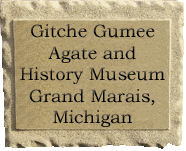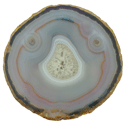MINERAL OF THE MONTH
Fall 2010 – Ammonite Fossil
The mineral of the month is the ammonite (Ammonoid) fossil. Ammonites are an extinct group of marine invertebrate animals from the Cephalopod class. These fossilized mollusks are more closely related to living cephalopods such as octopuses and squid, than they are to the modern nautilus, which has a similarly shaped shell. Two pictures of ammonite fossils are below. I took the first photo and Tom Shearer took the other two photos (Figures 135 & 136 in the new agate book).
Ammonites are excellent index fossils. Depending on the species of ammonite found in a rock layer, geologists can specify the geologic time period for that layer.
The name ammonite was inspired by the spiral shape of the fossilized shells, which somewhat resemble tightly-coiled rams' horns. The Egyptian god, Ammon, was typically depicted wearing rams' horns.
Eight different orders of ammonites are known to have existed, ranging from 400 million to 65.5 million years ago. They ranged in size from a fraction of an inch to over 7 feet in diameter. After being born, they fed on plankton and quickly assumed a strong protective outer shell. They also grew quickly with the females growing up to 400 percent larger than the males because they needed the extra space for egg production.
Because ammonites are extinct, little is known about their way of life. Their soft body parts were very rarely preserved in any detail. It is thought that depending on the species, they lived in a variety of ocean environments. Some probably lived in open water, while others survived at the bottom of the ocean. It is also believed that ammonites may have avoided becoming a predator's dinner by squirting ink, much like modern cephalopods.
The soft body of the organism occupied the largest segment of the shell at the end of the coil. The smaller sections were walled off which allowed the animal to maintain its buoyancy by either filling the chambers with gas, or emptying the sea water out of these chambers. Thus the smaller sections of the coil would have floated above the larger sections. As it grew, it added newer and larger chambers to the open end of the coil.
In medieval Europe, fossil ammonites were thought to be petrified coiled snakes. These fossils were often called "snakestones" or "serpentstones."
Mineral of the Month Archives
May 2007: Rainbow Fluorite
June 2007: Lake Superior Michipicoten Agate
July 2007: Labadorite
August 2007: Rain Flower Agate
Fall 2007: Malachite
December 2007: Nepheline Syenite
January 2008: Native Copper
February 2008: Amazonite
March 2008: Lake Superior Agate
April 2008: Shadow Agate
May 2008: Apohpylite
June 2008: Ocean Jasper
Summer 2008: Marra Mamba Tiger's Eye
September 2008: Mohawkite
October 2008: Mexican opal
November 2008: Prehnite
December 2008: Picture Jasper
January 2009: Sea Shell Jasper
February 2009: Polychrome Jasper
March 2009: Selenite Desert Rose
Spring 2009: Coyamito Agate
July 2009: Obsidian Needles
August 2009: Goethite
September 2009: Banded Iron Formation
Fall 2009: Fairburn Agate
March 2010: Fossilized Dinosaur Bone
April/May: 2010 Kentucky Agate
June 2010: Nantan Meteorite
July 2010: Mookaite Jasper
Aug/Sept 2010: Polyhedroid Agate
Fall 2010: Ammonite Fossil
September 2011: Petoskey Stones
Spring 2011: Petrfied Wood
Winter 2011: Argentina Condor Agate
January 2012: Mary Ellen Jasper
March 2012: Mexican Crazy Lace Agate
June 2012: Moqui Marbles
September 2012: Chlorastrolite Greenstone
March 2013: Jacobsville Sandstone
August 2013: Unakite
November 2013: Skip-an-Atom Agate
April 2014: Tiger's Eye
September 2014: Black Corundum
February 2015: Condor Agate
June 2015: Petoskey Stone
November 2015: Slag
June 2016: Lake Superior Copper Replacement Agates
March 2017: Chert
July 2017: Kona Dolomite
December 2017: Septarian Nodule
Copyright All rights reserved.
Gitche Gumee Museum.
E21739 Brazel Street
Grand Marais, Michigan 49839









